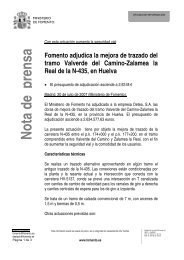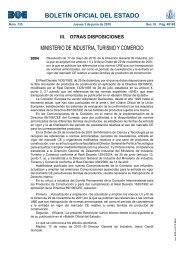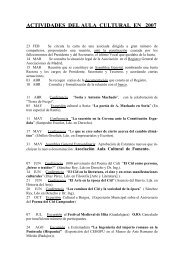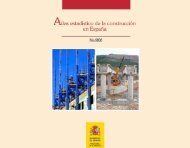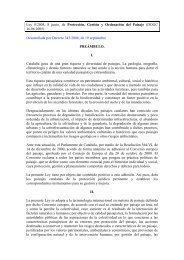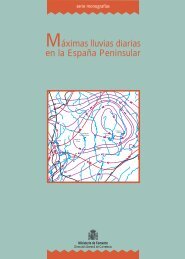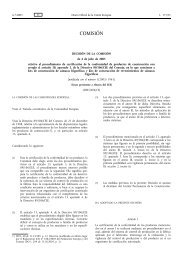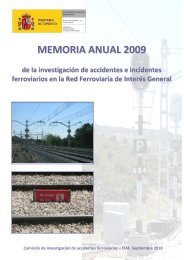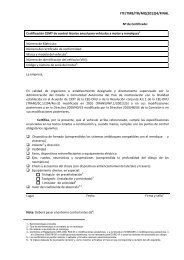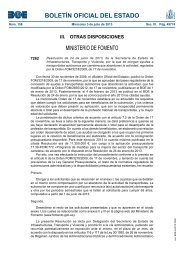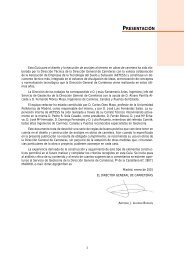atlas of urban vulnerability in spain: methodology and contents
atlas of urban vulnerability in spain: methodology and contents
atlas of urban vulnerability in spain: methodology and contents
Create successful ePaper yourself
Turn your PDF publications into a flip-book with our unique Google optimized e-Paper software.
IDS: INDEXES OF SOCIOECONOM IC INEQUITY.<br />
(81) IDSM: Index <strong>of</strong> Socioeconomic Inequity at Municipal level.<br />
IDSM is the result <strong>of</strong> the addition <strong>of</strong> the Percentage <strong>of</strong> unemployed population<br />
<strong>and</strong> Percentage <strong>of</strong> illiterate (or without basic education) population (Basic<br />
Indicators <strong>of</strong> Urban Vulnerability), once they have been st<strong>and</strong>ardised with<br />
respect to their respective municipal values us<strong>in</strong>g the chi-square method, <strong>and</strong><br />
applied a logarithm transformation to adjust their distribution.<br />
(82) IDSR: Index <strong>of</strong> Socioeconomic Inequity at Regional level.<br />
IDSR is the result <strong>of</strong> the addition <strong>of</strong> the Percentage <strong>of</strong> unemployed population<br />
<strong>and</strong> Percentage <strong>of</strong> illiterate (or without basic education) population (Basic<br />
Indicators <strong>of</strong> Urban Vulnerability), once they have been st<strong>and</strong>ardised with<br />
respect to the values <strong>of</strong> their respective region (Autonomous Communities)<br />
us<strong>in</strong>g the chi-square method, <strong>and</strong> applied a logarithm transformation to adjust<br />
their distribution.<br />
(83) IDSN: Index <strong>of</strong> Socioeconomic Inequity at National level.<br />
IDSN is the result <strong>of</strong> the addition <strong>of</strong> the Percentage <strong>of</strong> unemployed population<br />
<strong>and</strong> Percentage <strong>of</strong> illiterate (or without basic education) population (Basic<br />
Indicators <strong>of</strong> Urban Vulnerability), once they have been st<strong>and</strong>ardised with<br />
respect to the national values us<strong>in</strong>g the chi-square method, <strong>and</strong> applied a<br />
logarithm transformation to adjust their distribution.<br />
IDU: INDEX OF URBAN INEQUITY.<br />
(84) IDUM: Index <strong>of</strong> Urban Inequity at Municipal level.<br />
IDUM is the result <strong>of</strong> the addition <strong>of</strong> the 3 Basic Indicators <strong>of</strong> Urban Vulnerability<br />
(Percentage <strong>of</strong> unemployed population, Percentage <strong>of</strong> illiterate (or without<br />
basic education) population <strong>and</strong> Percentage <strong>of</strong> population <strong>in</strong> dwell<strong>in</strong>gs without<br />
toilet or WC), once they have been st<strong>and</strong>ardised with respect to their<br />
respective municipal values us<strong>in</strong>g the chi-square method, <strong>and</strong> applied a<br />
logarithm transformation to adjust their distribution.<br />
(85) IDUR: Index <strong>of</strong> Urban Inequity at Regional level.<br />
IDUR is the result <strong>of</strong> the addition <strong>of</strong> the 3 Basic Indicators <strong>of</strong> Urban Vulnerability<br />
(Percentage <strong>of</strong> unemployed population, Percentage <strong>of</strong> illiterate (or without<br />
basic education) population <strong>and</strong> Percentage <strong>of</strong> population <strong>in</strong> dwell<strong>in</strong>gs without<br />
toilet or WC), once they have been st<strong>and</strong>ardised with respect to the values <strong>of</strong><br />
their respective region (Autonomous Communities) us<strong>in</strong>g the chi-square<br />
method, <strong>and</strong> applied a logarithm transformation to adjust their distribution.<br />
(86) IDUN: Index <strong>of</strong> Urban Inequity at National level.<br />
IDUN is the result <strong>of</strong> the addition <strong>of</strong> the 3 Basic Indicators <strong>of</strong> Urban Vulnerability<br />
(Percentage <strong>of</strong> unemployed population, Percentage <strong>of</strong> illiterate (or without<br />
basic education) population <strong>and</strong> Percentage <strong>of</strong> population <strong>in</strong> dwell<strong>in</strong>gs without<br />
toilet or WC), once they have been st<strong>and</strong>ardised with respect to the national<br />
ATLAS OF URBAN VULNERABILITY IN SPAIN.<br />
METHODOLOGY AND CONTENTS. PAG. 25




